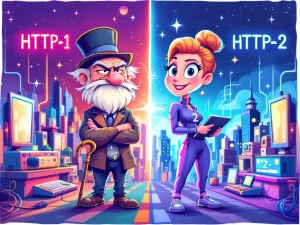الدورات
title
Laravel Sanctum vs Passport vs JWT: Choosing the Right Authentication for Your Application

Introduction
Authentication is a critical part of any Laravel application — whether it’s a Single Page Application (SPA), a mobile app, or a REST API.
Laravel provides several built-in authentication options to suit different project architectures, including Sanctum, Passport, and JWT (JSON Web Token).
In this article, we’ll explore:
- What Laravel Sanctum is and when to use it
- The difference between Sanctum and Passport
- How JWT fits into modern Laravel authentication
- Real-world recommendations for each scenario
1. Laravel Sanctum: Simple and Lightweight Authentication
Laravel Sanctum is a lightweight authentication system introduced to make token-based authentication simple and elegant.
It is the best choice if your:
- SPA (Single Page Application) and API are hosted under the same domain or subdomain,
- or you want simple API tokens without complex OAuth2 flows.
How Sanctum Works
Sanctum provides two main features:
- SPA Authentication using Laravel’s built-in session cookies
- Ideal for apps like
app.example.comcommunicating withexample.com/api. - Sanctum uses CSRF protection and Laravel sessions behind the scenes.
- API Token Authentication
- Each user can generate multiple API tokens with specific permissions (scopes).
- Perfect for mobile apps or third-party integrations that only require basic authentication.
Example:
// Issue a token
$token = $user->createToken('mobile-app')->plainTextToken;
// Use it in API calls
Authorization: Bearer <token>
Advantages of Sanctum
- Very lightweight and fast.
- Simple setup (no OAuth2 complexity).
- Works perfectly with SPAs under the same domain.
- Supports token permissions.
When to Use Sanctum
Choose Sanctum if:
- Your frontend and backend share the same domain (e.g.
example.comandapi.example.com). - You’re building a simple SPA, mobile app, or internal system.
- You don’t need OAuth2 or third-party access.
2. Laravel Passport: Full OAuth2 Authentication
Laravel Passport is Laravel’s official OAuth2 server implementation, built on top of the League OAuth2 package.
It’s a more complex but powerful system used when your app needs:
- Authorization between different domains, or
- Access tokens for third-party clients (like Google or Facebook integration).
How Passport Works
In OAuth2, the user logs in on the authentication server and grants access to the client.
For example:
Your SPA: spa.dev Your API: api.dev
When the SPA tries to log in, it is redirected to api.dev for authentication.
Once approved, the user receives an access token that allows secure communication between the SPA and the API.
Advantages of Passport
- Implements full OAuth2 protocol (Access Tokens, Refresh Tokens, Scopes).
- Ideal for multi-domain applications or third-party app access.
- Highly secure and standardized.
Disadvantages
- Heavy setup and configuration.
- Overkill for small or internal projects.
- Token handling and refresh can be more complex.
When to Use Passport
Choose Passport if:
- Your SPA and API live on different domains (e.g.,
spa.dev→api.dev). - You’re building a multi-service system or public API.
- You need third-party authentication or OAuth2 compliance.
3. JWT (JSON Web Token) Authentication
JWT (JSON Web Token) is a popular standard for transmitting secure data between parties as a signed token.
It’s not Laravel-specific — it can be implemented with any backend using libraries such as tymon/jwt-auth.
Unlike Sanctum or Passport, JWT doesn’t rely on sessions or cookies — it’s fully stateless.
How JWT Works
- The user logs in and receives a signed JWT token.
- The frontend stores it (e.g., in localStorage or memory).
- Every API request includes the token in the
Authorizationheader. - The backend verifies the token’s signature and grants access.
Example
Authorization: Bearer eyJhbGciOiJIUzI1NiIsInR5cCI6IkpXVCJ9...
Advantages
- Works across any domain or platform.
- Fully stateless (no sessions).
- Ideal for microservices or distributed systems.
Disadvantages
- No built-in token revocation (you must implement blacklists).
- If stored insecurely in localStorage, it can be vulnerable to XSS attacks.
- More setup effort compared to Sanctum.
When to Use JWT
Choose JWT if:
- You need cross-domain authentication but don’t require full OAuth2.
- You want stateless APIs that scale horizontally.
- You’re integrating Laravel with non-Laravel clients (React, Node.js, etc.).
4. Sanctum vs Passport vs JWT — Quick Comparison
FeatureSanctumPassportJWTComplexityLowHighMediumProtocolSimple token / sessionOAuth2Custom / StatelessBest ForSPAs & same-domain APIsMulti-domain / third-party accessMicroservices / stateless APIsToken RevocationYesYesManualSetup TimeEasyComplexModerateCross-Domain SupportNo (same domain only)YesYesBuilt into Laravel Native Native Third-party packageRecommended Use CaseLaravel SPA or mobile appOAuth2 or public APIStateless distributed system
5. Which One Should You Use?
ScenarioRecommended AuthenticationLaravel SPA + API under same domainSanctumLaravel SPA + API under different domainsPassportMobile App + Laravel APISanctum or JWTThird-party app integrationPassport (OAuth2)High-performance microservicesJWTInternal company systemSanctum
6. Example: SPA with Laravel Sanctum
If your project’s frontend and backend share the same top-level domain (e.g. frontend.example.com and api.example.com), Sanctum is the best option.
Key points:
- Sanctum uses CSRF cookies to protect requests.
- You only need to configure
CORSandSESSION_DOMAINproperly. - No token refresh is required; Laravel handles sessions automatically.
7. Final Thoughts
Each authentication system has its place:
- Sanctum — lightweight and ideal for most Laravel SPAs or mobile apps under the same domain.
- Passport — powerful and secure, suitable for OAuth2-based or cross-domain apps.
- JWT — flexible and language-agnostic for stateless microservices.
Unless your app specifically needs OAuth2 or external integrations, Laravel Sanctum remains the best and simplest choice for modern applications.






